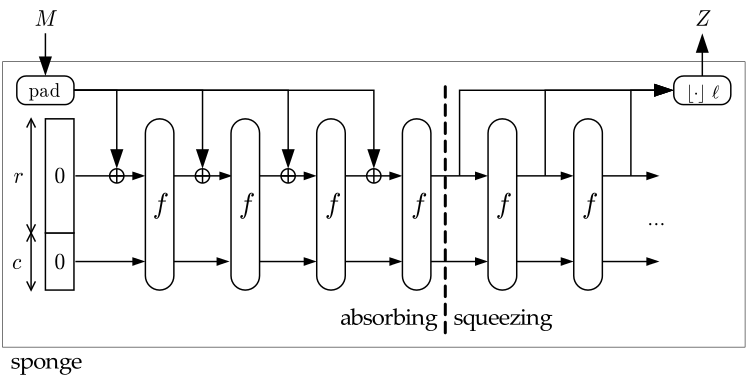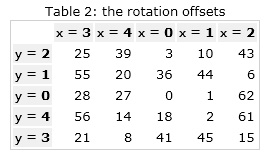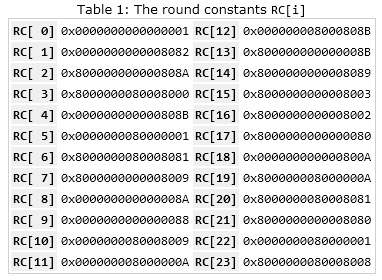Keccak, the new standard for data hashing
- Tutorial
 Good day, dear readers.
Good day, dear readers. Many of you probably know that for several years NIST held a hash function contest to adopt the new SHA-3 standard. And this year the award found its hero. The new standard has been safely adopted.
Well, since the standard has already been adopted, it's time to see what it is.
And on a quiet Saturday night, I, having
Prelude
The Keccak hash function with a variable output length of 224,256,384 and 512 bits was chosen as the new standard. At the heart of Keccak is a design called Sponge (the sponge, the same from the top image).
This design can be represented as follows:

As can be seen from the figure, the circuit consists of two stages:
- Absorbing The original message M undergoes multi-round permutations f.
- Squeezing (release). Conclusion of the resulting Z value as a result of permutations.
An attentive reader must have noticed the letters r and c in the figure. We will not reveal the intrigue ahead of time, let’s just say by varying the value of these variables, we will get completely different hash functions. So for SHA-512, r = 576, c = 1024 should be selected as these values.
And detail?
So, as I said above, the Keccak algorithm is based on the Sponge construct. This means that in order to obtain a hash, we need to do the following simple actions:
- Take the original message M and add it to a length multiple of r. Addition rules captivate with its simplicity. In the form of a formula, they can be represented as follows: M = M || 0x01 || 0x00 || .. || 0x00 || 0x80. Or, speaking in Russian, a single byte is added to the message, the required number of zeros, and this whole ensemble completes the byte with a value of 0x80.
UPD: All of the above applies only when more than one byte is added. However, in case it is necessary to complete only one byte, then it is enough to add only 0x81. The error was revealed thanks to the vigilance of the respected OverQuantum . And even earlier fabc spoke about itwhose post in the sandbox was unnoticed, but now justice has triumphed. Therefore, the code must be rewritten with this in mind! - Then, for each block M i of length r bits, we perform:
- Modulo 2 addition with the first r-bits of the set of initial states S. Before the function starts, all elements of S will be zero.
- We apply the function f to the resulting data N times. The set of initial states S for block M i + 1 will be the result of the last round of block M i .
- After all the blocks M i have finished, take the final result and return it as a hash value.
Anyway, nothing is clear!
Well, now the whole ins and outs of the algorithm with
But first, let us tear off the veils of secrecy and tell us why the parameters r and c are needed.
For this, it must be said that the Keccak hash function is implemented in such a way that the user can select the permutation function f used for each block M i from a set of predefined functions b = {f-25, f-50, f-100, f -200, f-400, f-800, f-1600}.
In order for your implementation to use, say, the f-800 function, you must select such r and c so that the equality r + c = 800 is satisfied.
In addition, by changing the values of r and c, you thereby change the number of rounds of your hash function. Because the number of these is calculated by the formula n = 12 + 2l, where 2l = (b / 25). So for b = 1600, the Number of rounds is 24.
However, although the user has the right to choose any of the functions proposed by the authors for their implementation, it should be noted that only the Keccak-1600 function is accepted as the SHA-3 standard and the authors strongly recommend using it only. So, as the main values for hashes of different lengths, the authors chose the following parameters:
SHA-224: r = 1156, c = 448 (return the first 28 bytes the result)
SHA-256: r = 1088, c = 512 (return the first 32 bytes the result)
SHA-384: r = 832, c = 768 (return the first 48 bytes the result)
SHA-512: r = 576, c = 1024 (return the first 64 bytes the result)
Where is the code?
And after all these explanations, you can already go directly to the pseudo-code of the algorithm.
The absorbing stage can be represented as the following function:
Keccak-f[b](A)
{
forall i in 0…nr-1
A = Round[b](A, RC[i])
return A
}
Here b is the value of the selected function (default is 1600). And the Round () function is a pseudo-random permutation applied on each round. The number of rounds nr is calculated from the values of r and c.
The operations performed on each round are the following function:
Round[b](A,RC)
{
θ step
for(int x=0; x<5; x++)
C[x] = A[x,0] xor A[x,1] xor A[x,2] xor A[x,3] xor A[x,4];
for(int x=0; x<5; x++)
D[x] = C[x-1] xor rot(C[x+1],1);
for(int x=0; x<5; x++)
A[x,y] = A[x,y] xor D[x];
ρ and π steps
for(int x=0; x<5; x++)
for(int y=0; y<5; y++)
B[y,2*x+3*y] = rot(A[x,y], r[x,y]);
χ step
for(int x=0; x<5; x++)
for(int y=0; y<5; y++)
A[x,y] = B[x,y] xor ((not B[x+1,y]) and B[x+2,y]);
ι step
A[0,0] = A[0,0] xor RC
return A
}
It consists of 4 steps on each of which a series of logical operations are performed on the incoming data.
Here the function rot (X, n) denotes a cyclic shift of an element X by n positions.
Array r [] is a predefined set of values that indicates how much bytes should be shifted in each round. The

values of all elements of this array are shown in the table below: RC array is a set of constants, which are also predefined:

The Keccak function itself is the following:
Keccak[r,c](M) {
Initialization and padding
for(int x=0; x<5; x++)
for(int y=0; y<5; y++)
S[x,y] = 0;
P = M || 0x01 || 0x00 || … || 0x00;
P = P xor (0x00 || … || 0x00 || 0x80);
//Absorbing phase
forall block Pi in P
for(int x=0; x<5; x++)
for(int y=0; y<5; y++)
S[x,y] = S[x,y] xor Pi[x+5*y];
S = Keccak-f[r+c](S);
//Squeezing phase
Z = empty string;
do
{
for(int x=0; x<5; x++)
for(int y=0; y<5; y++)
if((x+5y)
На этапе Absorbig производится вычисление хеш значения.
А на этапе Squeezing вывод результатов до тех пор пока не будет достигнута требуемая длина хеша.
Под спойлером небольшой класс, написанный на C#, реализующий все эти действия
public class Keccack
{
//константы рандов, всего их 24
//применяются на шаге ι
private ulong[] RC ={0x0000000000000001,
0x0000000000008082,
0x800000000000808A,
0x8000000080008000,
0x000000000000808B,
0x0000000080000001,
0x8000000080008081,
0x8000000000008009,
0x000000000000008A,
0x0000000000000088,
0x0000000080008009,
0x000000008000000A,
0x000000008000808B,
0x800000000000008B,
0x8000000000008089,
0x8000000000008003,
0x8000000000008002,
0x8000000000000080,
0x000000000000800A,
0x800000008000000A,
0x8000000080008081,
0x8000000000008080,
0x0000000080000001,
0x8000000080008008};
//матрица смещений, применяется при каждом раунде на шаге θ
private int[,] r = {{0, 36, 3, 41, 18} ,
{1, 44, 10, 45, 2} ,
{62, 6, 43, 15, 61} ,
{28, 55, 25, 21, 56} ,
{27, 20, 39, 8, 14} };
private int w, l, n;
//в конструкторе устанавливаем параметры функции b=1600
public Keccack(int b)
{
w = b / 25;
l = (Convert.ToInt32(Math.Log(w, 2)));
n = 12 + 2 * l;
}
//циклический сдвиг переменной x на n бит
private ulong rot(ulong x, int n)
{
n = n % w;
return (((x << n) | (x >> (w - n))));
}
private ulong[,] roundB(ulong[,] A, ulong RC)
{
ulong[] C = new ulong[5];
ulong[] D = new ulong[5];
ulong[,] B = new ulong[5, 5];
//шаг θ
for (int i = 0; i < 5; i++)
C[i] = A[i, 0] ^ A[i, 1] ^ A[i, 2] ^ A[i, 3] ^ A[i, 4];
for (int i = 0; i < 5; i++)
D[i] = C[(i + 4) % 5] ^ rot(C[(i + 1) % 5], 1);
for (int i = 0; i < 5; i++)
for (int j = 0; j < 5; j++)
A[i, j] = A[i, j] ^ D[i];
//шаги ρ и π
for (int i = 0; i < 5; i++)
for (int j = 0; j < 5; j++)
B[j, (2 * i + 3 * j) % 5] = rot(A[i, j], r[i, j]);
//шаг χ
for (int i = 0; i < 5; i++)
for (int j = 0; j < 5; j++)
A[i, j] = B[i, j] ^ ((~B[(i + 1) % 5, j]) & B[(i + 2) % 5, j]);
//шаг ι
A[0, 0] = A[0, 0] ^ RC;
return A;
}
private ulong[,] Keccackf(ulong[,] A)
{
for (int i = 0; i < n; i++)
A = roundB(A, RC[i]);
return A;
}
//функция дополняет 16-чную строку до размер r-байт и преобразует ее в матрицу 64-битных слов
private ulong[][] padding(string M, int r)
{
int size = 0;
//дополняем сообщение до длины кратной r
M = M + "01";
while (((M.Length / 2) * 8 % r) != ((r - 8)))
{
M = M + "00";
} ;
M = M + "80";
//получаем из скольки блоков длиной b-бит состоит сообщение
size = (((M.Length / 2) * 8) / r);
//инициальзируем массив массивов 64-битных слов
ulong[][] arrayM = new ulong[size][];
arrayM[0] = new ulong[1600 / w];
string temp = "";
int count = 0;
int j = 0;
int i = 0;
//конвертируем строковое представление в массив 64-битных слов
foreach (char ch in M)
{
if (j > (r/w-1))
{
j = 0;
i++;
arrayM[i] = new ulong[1600 / w];
}
count++;
if ((count * 4 % w) == 0)
{
arrayM[i][j] = Convert.ToUInt64(M.Substring((count - w / 4), w / 4), 16);
temp = ToReverseHexString(arrayM[i][j]);
arrayM[i][j] = Convert.ToUInt64(temp, 16);
j++;
}
}
return arrayM;
}
private string ToReverseHexString(ulong S)
{
string temp = BitConverter.ToString(BitConverter.GetBytes(S).ToArray()).Replace("-", "");
return temp;
}
private string ToHexString(ulong S)
{
string temp = BitConverter.ToString(BitConverter.GetBytes(S).Reverse().ToArray()).Replace("-", "");
return temp;
}
//
public string GetHash(string M, int r, int c, int d)
{
//Забиваем начальное значение матрицы S=0
ulong[,] S = new ulong[5, 5];
for (int i = 0; i < 5; i++)
for (int j = 0; j < 5; j++)
S[i, j] = 0;
ulong[][] P = padding(M, r);
//Сообщение P представляет собой массив элементов Pi,
//каждый из которых в свою очередь является массивом 64-битных элементов
foreach (ulong[] Pi in P)
{
for (int i = 0; i < 5; i++)
for (int j = 0; j < 5; j++)
if((i + j * 5)<(r/w))
S[i, j] = S[i, j] ^ Pi[i + j * 5];
Keccackf(S);
}
string Z = "";
//добавляем к возвращаемой строке значения, пока не достигнем нужной длины
do
{
for (int i = 0; i < 5; i++)
for (int j = 0; j < 5; j++)
if ((5*i + j) < (r / w))
Z = Z + ToReverseHexString(S[j, i]);
Keccackf(S);
} while (Z.Length < d*2);
return Z.Substring(0, d * 2);
}
}
Скачать исходники вы можете отсюда.
P.S. все материалы и иллюстрации для этой статьи были найдены на официальном сайте хеш-функции Keccak.
UPD: fshp любезно поделился ссылкой на русскоязычное описание основных возможностей нового стандарта.
UPD2: после опубликовая статьи ко мне на почту обратился читатель с ником Admiral. Он предложил более оптимизированный код, в котором не используется работа со строками.
Реализация читателя Admiralusing System;
using System.Linq;
using System.Collections.Generic;
class Program
{
/*const */
static private Byte InstanceNumber = 6;
/*const */
static private UInt16[] b_array = { 25, 50, 100, 200, 400, 800, 1600 }; //permutation_width
/*const */
static private Byte matrixSize = 5 * 5;
/*const */
static private Byte[] w_array = { 1, 2, 4, 8, 16, 32, 64 }; //b / 25;
/*const */
static private Byte[] l_array = { 0, 1, 2, 3, 4, 5, 6 }; //log(static_cast(m_w)) / log(2.0F)
/*const */
static private Byte[] n_array = { 12, 14, 16, 18, 20, 22, 24 }; //12 + 2 * l -> number_of_permutation
/*const */
static private Byte[,] r = {
{0, 36, 3, 41, 18},
{1, 44, 10, 45, 2},
{62, 6, 43, 15, 61},
{28, 55, 25, 21, 56},
{27, 20, 39, 8, 14}
};
/*const */
static private UInt64[] RC = {//24 by w_array[KeccakInstanceCount - 1] (for 1600), for less please use less in w_array
0x0000000000000001,
0x0000000000008082,
0x800000000000808A,
0x8000000080008000,
0x000000000000808B,
0x0000000080000001,
0x8000000080008081,
0x8000000000008009,
0x000000000000008A,
0x0000000000000088,
0x0000000080008009,
0x000000008000000A,
0x000000008000808B,
0x800000000000008B,
0x8000000000008089,
0x8000000000008003,
0x8000000000008002,
0x8000000000000080,
0x000000000000800A,
0x800000008000000A,
0x8000000080008081,
0x8000000000008080,
0x0000000080000001,
0x8000000080008008
};
static private UInt64[,] B = new UInt64[5, 5];
static private UInt64[] C = new UInt64[5];
static private UInt64[] D = new UInt64[5];
/*const*/
static public UInt16[] rate_array = { 576, 832, 1024, 1088, 1152, 1216, 1280, 1344, 1408 };
/*const*/
static public UInt16[] capacity_array = { 1024, 768, 576, 512, 448, 384, 320, 256, 192 };
public enum SHA3 { SHA512 = 0, SHA384, SHA256 = 3, SHA224 };
static private UInt64[,] Keccak_f(UInt64[,] A)
{
for(Byte i = 0; i < n_array[InstanceNumber]; i++)
A = Round(A, RC[i]);
return A;
}
static private UInt64[,] Round(UInt64[,] A, UInt64 RC_i)
{
Byte i, j;
//theta step
for (i = 0; i < 5; i++)
C[i] = A[i,0] ^ A[i,1] ^ A[i,2] ^ A[i,3] ^ A[i,4];
for (i = 0; i < 5; i++)
D[i] = C[(i + 4) % 5] ^ ROT(C[(i + 1) % 5], 1, w_array[InstanceNumber]);
for (i = 0; i < 5; i++)
for (j = 0; j < 5; j++)
A[i,j] = A[i,j] ^ D[i];
//rho and pi steps
for (i = 0; i < 5; i++)
for (j = 0; j < 5; j++)
B[j,(2 * i + 3 * j) % 5] = ROT(A[i,j], r[i,j], w_array[InstanceNumber]);
//chi step
for (i = 0; i < 5; i++)
for (j = 0; j < 5; j++)
A[i,j] = B[i,j] ^ ((~B[(i + 1) % 5,j]) & B[(i + 2) % 5,j]);
//iota step
A[0,0] = A[0,0] ^ RC_i;
return A;
}
static private UInt64 ROT(UInt64 x, Byte n, Byte w)
{
return ((x << (n % w)) | (x >> (w - (n % w))));
}
static private Byte[] Keccak(UInt16 rate, UInt16 capacity, List Message)
{
//Padding
Message.Add(0x01);
UInt16 min = (UInt16)((rate - 8) / 8);
UInt16 n = (UInt16)Math.Truncate((Double)(Message.Count / min));
UInt32 messageFullCount = 0;
if (n < 2)
{
messageFullCount = min;
}
else
{
messageFullCount = (UInt32)(n * min + (n - 1));
}
UInt32 delta = (UInt32)(messageFullCount - Message.Count);
if ((Message.Count + delta) > UInt16.MaxValue - 1)
throw (new Exception("Message might be too large"));
/*Byte[] byteArrayToAdd = new Byte[delta];
Message.AddRange(byteArrayToAdd);*/
while (delta > 0)
{
Message.Add(0x00);
delta--;
}
if ((Message.Count * 8 % rate) != (rate - 8))
throw (new Exception("Length was incorect calculated"));
Message.Add(0x80);
/*const*/
Int32 size = (Message.Count * 8) / rate;
UInt64[] P = new UInt64[size * matrixSize];
Int32 xF = 0, count = 0;
Byte i = 0, j = 0;
for(xF = 0; xF < Message.Count; xF++)
{
if (j > (rate / w_array[InstanceNumber] - 1))
{
j = 0;
i++;
}
count++;
if ((count * 8 % w_array[InstanceNumber]) == 0)
{
P[size * i + j] = ReverseEightBytesAndToUInt64(
Message.GetRange(count - w_array[InstanceNumber] / 8, 8).ToArray()
);
j++;
}
}
//Initialization
UInt64 [,]S = new UInt64[5,5];
for(i = 0; i < 5; i++)
for(j = 0; j < 5; j++)
S[i,j] = 0;
//Absorting phase
for(xF = 0; xF < size; xF++)
{
for(i = 0; i < 5; i++)
for(j = 0; j < 5; j++)
if ((i + j * 5) < (rate / w_array[InstanceNumber]))
{
S[i, j] = S[i, j] ^ P[size * xF + i + j * 5];
}
Keccak_f(S);
}
//Squeezing phaze
Byte a = 0;
Byte d_max = (Byte)(capacity / (2 * 8));
List retHash = new List(d_max);
for( ; ; )
{
for(i = 0; i < 5; i++)
for(j = 0; j < 5; j++)
if((5 * i + j) < (rate / w_array[InstanceNumber]))
{
if(a >= d_max)
i = j = 5;
else
{
retHash.AddRange(FromUInt64ToReverseEightBytes(S[j, i]));
a = (Byte)retHash.Count;
}
}
if(a >= d_max)
break;
Keccak_f(S);
}
return retHash.GetRange(0, d_max).ToArray();
}
static private UInt64 ReverseEightBytesAndToUInt64(Byte[] bVal)
{
UInt64 ulVal = 0L;
for (Byte i = 8, j = 0; i > 0; i--)
{
ulVal += (UInt64)((bVal[i - 1] & 0xF0) >> 4) * (UInt64)Math.Pow(16.0F, 15 - (j++));
ulVal += (UInt64)(bVal[i - 1] & 0x0F) * (UInt64)Math.Pow(16.0F, 15 - (j++));
}
return ulVal;
}
static private Byte[] FromUInt64ToReverseEightBytes(UInt64 ulVal)
{
Byte[] bVal = new Byte[8];
Byte a = 0;
do
{
bVal[a] = (Byte)((ulVal % 16) * 1);
ulVal = ulVal / 16;
bVal[a] += (Byte)((ulVal % 16) * 16);
a++;
}
while (15 < (ulVal = ulVal / 16));
while (a < 8)
{
bVal[a++] = (Byte)ulVal;
ulVal = 0;
}
return bVal;
}
static void Main(String[] args)
{
if (args.Length < 1)
return;
List MessageB;
String message = string.Copy(args[0]);
MessageB = strToByteList(message);
String hash_224 = ByteArrayToString(Keccak(rate_array[(Byte)SHA3.SHA224], capacity_array[(Byte)SHA3.SHA224], MessageB));
MessageB = strToByteList(message);
String hash_256 = ByteArrayToString(Keccak(rate_array[(Byte)SHA3.SHA256], capacity_array[(Byte)SHA3.SHA256], MessageB));
MessageB = strToByteList(message);
String hash_384 = ByteArrayToString(Keccak(rate_array[(Byte)SHA3.SHA384], capacity_array[(Byte)SHA3.SHA384], MessageB));
MessageB = strToByteList(message);
String hash_512 = ByteArrayToString(Keccak(rate_array[(Byte)SHA3.SHA512], capacity_array[(Byte)SHA3.SHA512], MessageB));
Console.WriteLine("Message: " + message + "\r\n" +
"Hash_224: " + hash_224 + "\r\n" +
"Hash_256: " + hash_256 + "\r\n" +
"Hash_384: " + hash_384 + "\r\n" +
"Hash_512: " + hash_512 + "\r\n");
}
static List strToByteList(String str)
{
List ret = new List(str.Length);
foreach(char ch in str)
{
ret.Add((Byte)ch);
}
return ret;
}
static public String ByteArrayToString(Byte[] b)
{
System.Text.StringBuilder sb = new System.Text.StringBuilder(16);
for (Int32 i = 0; i < Math.Min(b.Length, Int32.MaxValue - 1); i++)
sb.Append(String.Format("{0:X2}", b[i]));
return sb.ToString();
}
}
